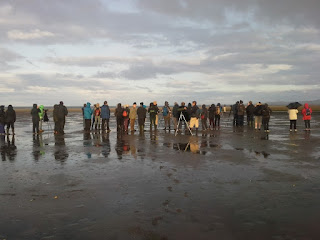World Wetlands Day is an international day of celebration, to commemorate the signing of the Ramsar Convention on Wetlands in the Iranian city of Ramsar in 1971. This massively important inter-governmental treaty provided the framework for the wise-use and conservation of wetlands around the world. It also formulated the criteria which are now used for identifying and placing legal protection on wetlands of significant importance. Dedicating a whole day to celebrating wetlands highlights their immense value and the need to protect them.
With that in mind, we have compiled a short summary of what makes Dublin Bay such an important wetland site and why we dedicate so much of our time to studying it! We have also given some suggestions of when, where and how you can access Dublin Bay and observe some of its magnificent avian spectacles.
 |
| World Wetlands Day 2019 Logo |
Dublin Bay is designated under EU legislation as a Special Protection Area (SPA) due to the numbers of wintering waterbirds it supports. It holds internationally important numbers of Light-bellied Brent Goose, Knot, Black-tailed Godwit and Bar-tailed Godwit, and nationally important numbers of several other species. During our DBBP surveys the Bay regularly supports in excess of 30,000 waterbirds of more than 40 species, and, according to the Irish Wetland Bird Survey, it ranks in the top five most important wintering waterbird sites in Ireland! Dublin Bay is also a key site for breeding Common and Arctic Terns which breed on several structures in the Dublin Port area in summer months. Furthermore, massive flocks of terns (20,000+ at times!) have been recorded roosting on the intertidal mudflats along the south Dublin Bay coastline each autumn before making onward journeys to the west African coast to overwinter in its more favourable climate.
 |
| Large feeding flock of Light-bellied Brent Geese - IBGRG |
Dublin Bay is a truly special wetland site and with its proximity to the capital city it is easily accessed by residents and visitors. Everyone should make an effort to visit the bay and see some of the wonderful natural spectacles on offer.
 |
| A flock of Golden Plover on the strand near Booterstown. Helen Boland. |
Some of the World Wetlands Day events in Ireland are listed here with the 'Birdwatching on Bull Island' talk and walk, organised by the Bull Island Volunteers, of particular relevance for Dublin-based people.
Seasonal avian highlights in Dublin Bay that you might consider checking out:
- Brent Geese freshly arrived from arctic northern Canada can be observed feeding on the coastal mudflats close to Clontarf from October onwards. This small goose species has become so habituated to humans in Dublin it offers a unique opportunity to get close to these urbanised Arctic migrants.
- Vast numbers of wintering waterbirds of geese, ducks, waders and gulls are found within the bay from October to March. At low tide the mudflats and marshes around Bull Island are alive with feeding flocks. You can observe flocks of Golden Plover and Knot, thousands strong, filling the skies above the wooden bridge as they whirl and roll in close formation.
- Breeding Terns are easily observed from the Great South Wall (GSW) on balmy June and July days as they commute to and from their nest sites along the River Liffey. Watch adult terns fish in the surf south of the GSW and return with beak-fulls of tiny fish prey to hungry chicks waiting impatiently further up river.
- From mid-August and into late September Sandymount Strand hosts a massive mixed flock of Common, Arctic and Roseate Terns. The birds coalesce into spectacular flocks as the evening light fades and before they roost overnight on the sandflats close to Merrion Gates. This is a natural spectacle that has become an annual pilgrimage for many wildlife enthusiasts.
 |
| A large group of birdwatchers gathers to observe tern flocks on Sandymount Strand. Jen Lynch. |
Accessing Dublin Bay by public transport:
- Dublin Bus 130 will take you from Lower Abbey Street all the way to Bull Island Wooden Bridge.
- The DART serves Clontarf Road Dart Station which is within easy walk of the Tolka Estuary, and a little longer walk on to Bull Island.
- The DART also serves Booterstown Dart Station which brings you into the thick of things on Sandymount Strand. You can even view the autumn tern gatherings from the pedestrian overpass at the station.
- A number of Dublin Bus routes (1,18 and 47) serve Seafort Ave, Marine Drive which will take you close to Irishtown Nature Reserve. Follow the coastal path that will bring you east onto Pigeon House Road, continue along the waters edge to the Great South Wall.
Hello, I'm Dr Obodo, a real and genuine spell caster/Spiritual healer with years of experience in spell casting and an expert in all spells, i specialize exclusively in LOVE SPELL/GET REUNITE WITH EX LOVER. They are all %100 Guaranteed QUICK Results, it most work. If you have any problem and you need a real and genuine spell caster to solve your problems. Note-you can also Text/Call on WhatsApp. Email: templeofanswer@hotmail .co .uk WhatsApp No: +(234)8155 42548-1
ReplyDeleteBreast oil is a topical medication that can be applied directly to the skin in order to reduce symptoms like dryness and discomfort. It's possible to get it from either plants or animals. Both are viable options. Moreover, it is used in the cosmetic business as an adjuvant with the goal of enhancing the appearance of breast tissue in order to sell more products. Breast oil can be made from a variety of plant-based oils, including those derived from jojoba, sunflower, and olives, to name just a few of the options. The production of breast oil can make use of a wide variety of animal fats and oils, including shea butter, yak butter, and cow milk, to name a few examples.
ReplyDelete